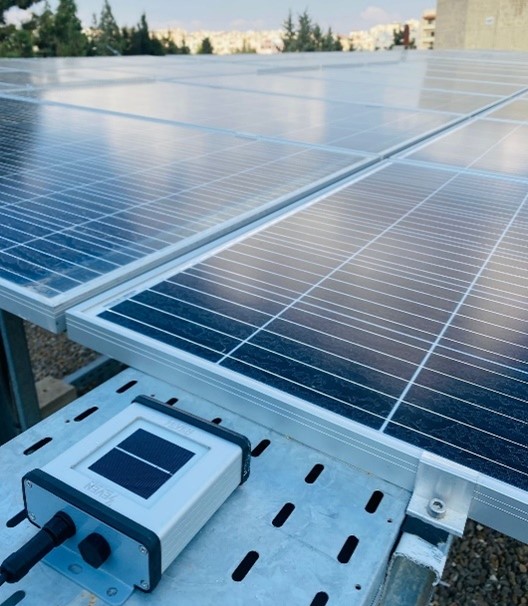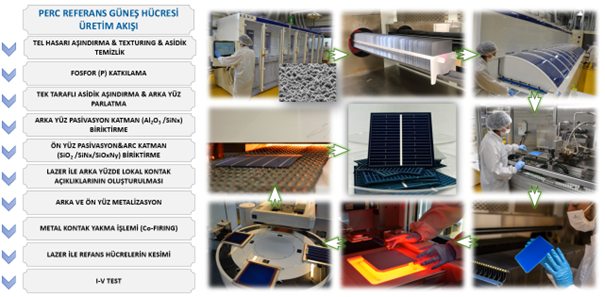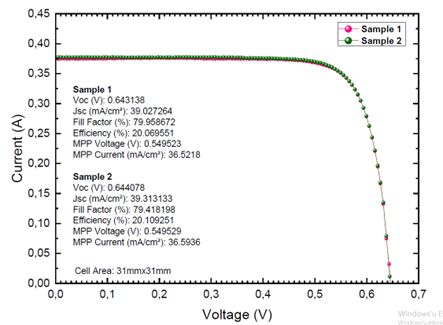Your cart is currently empty!
The Reference Cells of SEVEN Sensor Are Manufactured by METU-GUNAM

The inclination towards renewable energy sources is increasing day by day both in the world and in our country. Solar Power Plants (SPPs) hold great importance and share in terms of renewable energy. In this field, numerous investment plans are being made aiming at the production of silicon ingots & wafers, cells, and modules in photovoltaic technology.
SPP users monitor the conversion of solar energy into electrical energy, that is, the production performance of the site. Performance monitoring is generally carried out based on the Performance Ratio (PR) included in monitoring systems, and accurate calculation of PR is of great importance in terms of energy production monitoring. Irradiance sensors play a significant role in measuring the amount of solar radiation received by photovoltaic panels. With the help of these sensors, data related to solar light intensity is crucial for monitoring and optimizing the performance of solar energy systems, contributing significantly to efficiency evaluations and system management. In order to ensure the reliability of these sensors, it is imperative to use stable reference cells with well-characterized features.
SEVEN Sensor Solutions is a manufacturer of Photovoltaic Pyranometers, also known as Reference Cell Irradiance Sensors, which can measure the radiation value that directly impacts the efficiency of the facility with the highest accuracy. The solar cells used in these sensors are identical in structure to those found in the field and are physically miniaturized. Thus, the radiation coming to the solar panels is measured by a solar cell with the same structure.
The reliability of the solar cells used in Irradiance Sensors directly affects the accuracy of the PR value. This means the cell must maintain its stability and perform accurate measurements over a long period under natural field conditions. SEVEN Sensor Solutions is collaborating with METU-GÜNAM on cell production. Together with this joint work, METU-GUNAM carries out the production of solar cells that maintain their stability for a long time and allow the most accurate measurement in its research and production infrastructure.
Photovoltaic Cells
Photovoltaic (PV) cells, commonly known as solar cells, are semiconductor devices that convert sunlight directly into electricity through the photovoltaic effect. This phenomenon is based on the interaction between photons and semiconductor materials and leads to the flow of electric current. There are many types of photovoltaic cells, depending on the material systems and designs they are produced with. In this context, it is of great importance to choose the cell type that will provide the most efficient performance depending on the field of application. While various types of reference cells are available in the current market for Irradiance Sensor production, advancements in material and design can contribute to higher accuracy and reliability. Crystalline silicon-based solar cells are preferred in the production of irradiance sensors due to their stable behavior and lifespan exceeding 20 years. The crystalline silicon-based PERC type solar cells proposed by METU-GÜNAM have been selected as the appropriate technology for SEVEN Irradiance Sensors’ precise irradiance measurements. Through rigorous manufacturing and testing, this work aims to contribute to the creation of a robust and reliable reference standard for irradiance sensors, facilitating accurate and consistent solar energy assessments.
PERC Cell Technology
Since its proposal, PERC cell technology has largely completed its maturation process and has been used in both power plant and roof applications for approximately ten years. The degradation behavior of the reference cell selection, significantly demonstrated in both laboratory test environments and the field, was considered important. PERC solar cell design for SEVEN Sensor Solutions is based on p-type silicon wafers and production is carried out with boron (B) or gallium (Ga) doped silicon wafers. In the production carried out within this study, gallium-doped p-type silicon wafers were preferred to avoid the Light Induced Degradation (LID) effect caused by Boron-Oxygen complexes formed by the combination of boron atoms within the substrate and oxygen atoms. The production was performed by defining 15 cells on 156.75mm x 156.75mm (M2) sized wafers with a thickness of 180±5µm, sized 3.1cm x 3.1cm. Subsequently, the reference cells were cut and prepared using a laser.
![]()
SEVEN Irradiance Sensor Cell Production
The production of PERC reference cells was carried out on the METU-GÜNAM photovoltaic pilot production line in accordance with the design determined for SEVEN with simulation studies. As the initial step, gallium-doped p-type silicon wafers underwent a wire damage etching process in a potassium hydroxide (KOH)/DI water solution to remove surface damage caused by wafer cutting. Following this, texturing was applied to reduce the surface reflection rate. With the texturing process, the reflection rate on the surface was reduced to ≈11% thanks to the pyramidal structures created by chemical etching. After texturing, phosphorus (P) doping process was applied on p-type silicon wafers to form the p-n junction. In the next step, the unwanted phosphorus-doped area on the back of the wafers was chemically etched in a single-sided etching system. After this process, passivation and ARC layers were sequentially created on both the front and back surfaces of the samples using Atomic Layer Deposition (ALD) and Plasma Enhanced Vapor Deposition (PECVD) techniques. Local contact openings were created with a laser on the back surface of the samples, which had completed the front and back surface passivation processes, making them ready for metallization. Aluminum contacts were formed on the back surface and silver contacts on the front surface of the produced PERC cells using the screen-printing method, and cell production was completed after thermal processing in a metallization firing furnace. The cell production flow is schematically provided below.

Cell Characterization Process
After production, PERC cells produced with special dimensions of 31 mm × 31 mm are subjected to an extensive testing and characterization process to evaluate their performance as reference cells for SEVEN Irradiance Sensors.
Electrical characterization begins with measuring critical parameters such as open-circuit voltage (VOC), short-circuit current (ISC), fill factor (FF), and efficiency (η). These measurements provide information about the electrical performance of the cell under standard test conditions (STC), ensuring that it meets industry standards in terms of accuracy and reliability. Solar simulators and optical and electrical testing equipment available within METU-GÜNAM Test Characterization Unit were used for this measurement. The results are clearly shown in the I-V graph below.

In addition to Optical and Electrical characterization, the temperature coefficient of PERC cells has been calculated to understand how their electrical performance changes with temperature changes. The temperature coefficient is typically expressed as the percentage change in cell parameters per degree Celsius change. In order to determine this coefficient, the cells produced were exposed to various temperatures, and a controlled temperature environment was created. The temperature range typically included both low and high extreme values to capture the full temperature coefficient range. The electrical parameters of the cells were measured at different temperatures within the specified range, and the collected data were used to calculate the temperature coefficient for each parameter. The calculated temperature coefficient value was found to be –0.045 %/K.
The Current Status of Reference Cells in the Industry:
Reference cells are critical components in the calibration and verification of irradiance sensors used in solar energy applications. They measure solar radiation and provide accurate and consistent performance assessments of solar panels and systems. Currently, reference cells are predominantly based on crystalline silicon (c-Si) technology, such as monocrystalline or multicrystalline silicon, with established standards like ASTM E927-10.
While c-Si reference cells are widely adopted, ongoing research aims to improve their accuracy, stability, and spectral response under various environmental conditions. Cells developed by METU-GÜNAM for SEVEN Sensor Solutions offer enhanced spectral matching and potentially increased durability.